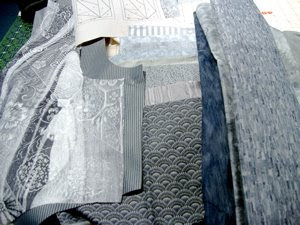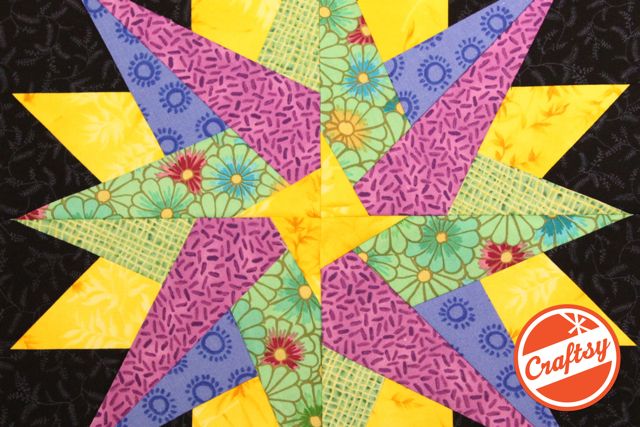Yesterd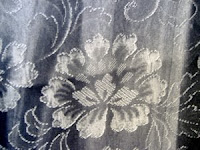 ay, I worked on my first vest side. I purchased this elegant Japanese silk fabric when I was teaching at Quilt Colorado and couldn’t wait to use it as the inspiration for this vest side. It has shades of grey with this wonderful raised white floral element. Working with such a neutral pallet will make this a very versatile vest to bring along on my teaching trips. It will go with anything! The first step, decide how to position the left vest front pattern on the fabric to take advantage of the best elements and direction of the lines in the fabric. I typically like to use vertical or diagonal lines that go from the center of the vest toward the upper portion of the vest to create the most flattering look.
ay, I worked on my first vest side. I purchased this elegant Japanese silk fabric when I was teaching at Quilt Colorado and couldn’t wait to use it as the inspiration for this vest side. It has shades of grey with this wonderful raised white floral element. Working with such a neutral pallet will make this a very versatile vest to bring along on my teaching trips. It will go with anything! The first step, decide how to position the left vest front pattern on the fabric to take advantage of the best elements and direction of the lines in the fabric. I typically like to use vertical or diagonal lines that go from the center of the vest toward the upper portion of the vest to create the most flattering look.
The second step is to gather a group of fabrics I want to use on the other vest front. I work in shades of color ranging slightly in value and texture. This step can make a mess of my work area as I pull fabrics and audition them. I give myself permission to just toss the rejects on the floor. I’ll deal with those fabrics later. I can’t be creative and neat at the same time. Arranging them in the way I plan to use them in the vest gives me a good perspective of the final product. In this photo, the vest front, the vest back and a group of fabrics are positioned. When I looked at this photo, I couldn’t help but think that it looked like a black and white photo, but the little bit of green cutting mat shows that it is not.

Now I am off to decide which paper-pieced block to use. I created several new blocks for the new book so using one of the new blocks was fun. Taking advantage of the perfect points you can achieve with paper piecing was also another consideration when choosing my block design. I chose a block that was simple but had a generic theme that would blend well with my focus fabric. Since the Japanese fabric had white raised elements, I decided on a dark background featuring white fabrics with different textures. I even used the Japanese fabric for the largest ray. The paper-pieced block is positioned on the vest front foundation and pinned in place. I then draw vertical pencil lines down the vest front even with the edges of the block. This is the area where I will place the short strips of fabric. There are two options here about removing the paper. You can carefully remove the paper now, or you can foundation piece around the block and remove the paper in the seam allowances as you piece and slit the back of the foundation to remove the remaining paper. This is a simple block, so I remove the paper now.
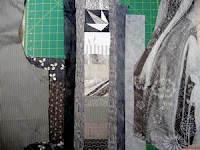
With my block complete, I cut the fabric strips for the short segments (here I am looking for a variety of fabrics and textures) and I cut the fabric strips for the long vertical strips used on each side. The vertical strips tend to be a bit more conservative color range, placing the slightly lighter strips toward the front of the vest and the darker strips toward the side of the vest. This gives the illusion that I am thinner than I am…gotta love that! One of the fabrics actually looked almost the same on the front and back, but was slightly lighter on the back. Great opportunity to use both sides of the fabric! Once the strips are cut, I position them on the vest foundation in the order I plan to sew them. The other vest front and the vest back are always in position so I can see how the patchwork side relates to the other vest front.
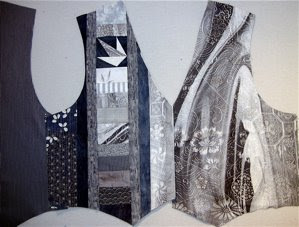
Once I am happy with the position of my strips, I move the foundation over to the sewing area and begin to foundation piece the strips. The short strips are sewn first and then the vertical strips. When all the strips are sewn to the foundation, I turn it over and trim the strips flush with the foundation. Now I get to stand back and see how the two vest fronts and back look together. I am pleased…….still looks like a black and white photograph.
Now I am off to go pick fabric for the other vest side. Having worked in such a neutral pallet for this side, I think I might just have color overload. I am going to use black on the other vest side, but add lots of color too. That is one of the really neat aspects of these reversible vests. You can use the same neutral color on both vest sides, but have different color schemes. Vest side two coming up!
All the best,
Carol
This entry was posted on Sunday, July 6th, 2008 at 8:03 am and is filed under Vests.
You can follow any responses to this entry through the RSS 2.0 feed.
You can leave a response, or trackback from your own site.
 ay, I worked on my first vest side. I purchased this elegant Japanese silk fabric when I was teaching at Quilt Colorado and couldn’t wait to use it as the inspiration for this vest side. It has shades of grey with this wonderful raised white floral element. Working with such a neutral pallet will make this a very versatile vest to bring along on my teaching trips. It will go with anything! The first step, decide how to position the left vest front pattern on the fabric to take advantage of the best elements and direction of the lines in the fabric. I typically like to use vertical or diagonal lines that go from the center of the vest toward the upper portion of the vest to create the most flattering look.
ay, I worked on my first vest side. I purchased this elegant Japanese silk fabric when I was teaching at Quilt Colorado and couldn’t wait to use it as the inspiration for this vest side. It has shades of grey with this wonderful raised white floral element. Working with such a neutral pallet will make this a very versatile vest to bring along on my teaching trips. It will go with anything! The first step, decide how to position the left vest front pattern on the fabric to take advantage of the best elements and direction of the lines in the fabric. I typically like to use vertical or diagonal lines that go from the center of the vest toward the upper portion of the vest to create the most flattering look.